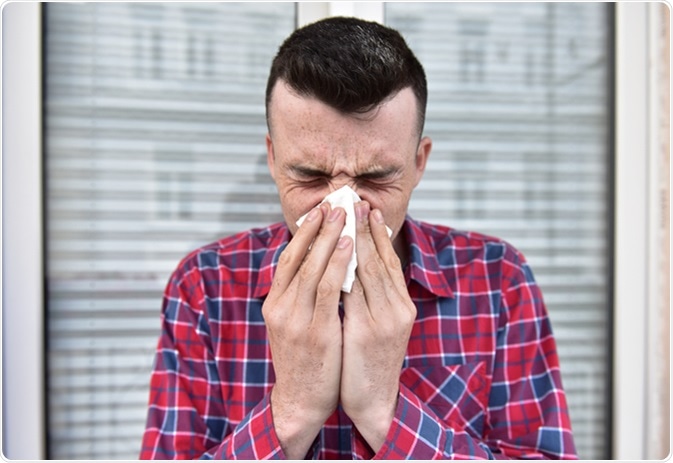
Walking Pneumonia Versus Common Cold
Since the common cold and walking pneumonia are both respiratory ailments, there are some similarities in their symptoms and causes. They are, however, both extremely different diseases which have different effects on the human body. The primary difference between them is that the Common Cold is usually caused by a viral infection while walking pneumonia is essentially a bacterial infection.

Image Credit: Estrada Anton / Shutterstock
What are the Symptoms of the Common Cold?
The common cold affects the vast majority of the population at least once a year. It is a viral infection affecting the upper respiratory tract. A variety of different viruses can cause the condition, but it is generally resolved in a couple of weeks. The symptoms include a runny nose, sneezing, coughing, headache, congestion and fever. Severity of symptoms may differ.
There is a general sense of lethargy in the body and muscle aches may be present. The nasal discharge will become thicker and change colour to yellow or green as the disease progresses. Possible secondary infections could include triggering of an asthma attack, acute sinusitis, otitis media or ear infection, and strep throat.
The Highly Contagious Nature of the Common Cold
The reason it’s called the common cold is that more than one billion people suffer from the disease in any given year in the United States alone. The common cold is the reason why most children miss school. It also passes on to the parents and keeps them from their jobs. It spreads really quickly as it is highly contagious. One can catch the common cold by simply being near a person who sneezes or coughs next to you, or if you shake hands with the infected person. You can even get infected by touching a doorknob or a toy which has been contaminated by an infected person.
It is a highly contagious disease and symptoms are usually seen a couple of days after exposure. There is no established cure for the common cold. Home remedies that seem effective in managing the disease include getting rest, drinking lots of fluids, gargling with saline water, and using cough drops to soothe the throat. Depending on the severity of the attack, the common cold can take between two to fourteen days to resolve.
Protecting Yourself from the Common Cold
The primary defence against the common cold is to ensure that you get a seasonal flu vaccine shot which will boost the body’s immune system. This will help the body fight against the influenza viruses that are commonly floating around in the upcoming season. Be proactive about avoiding close contact with people who have the common cold.
Maintain a physical distance from them when possible, and if you are the one who is ill, stay away from school or work to avoid spreading the germs. Wash your hands often with warm water and soap. Cover your mouth and nose with a disposable tissue when coughing or sneezing and ensure that you discard the tissues in a sterile manner.
What is Walking Pneumonia?
Pneumonia is an inflammation of the lungs which can be bacterial, viral or fungal in nature. It may affect one or both lungs. The infection causes the alveoli, air sacs within the lungs, to fill up with pus or fluid. walking pneumonia refers to the kind of pneumonia caused by a bacterial infection that damages the lining of the respiratory system, including the throat, lungs and windpipe. It is caused by the bacterium mycoplasma pneumoniae.
The symptoms of walking pneumonia include a sore throat, feeling of fatigue, headache, fever and a slowly worsening cough. Some may exhibit wheezing or vomiting. One of three people who develop this disease will actually see it escalate to full blown pneumonia. It can last from one to four weeks. If symptoms do not deteriorate the patient may never seek medical assistance and symptoms will be cured on their own after a month.
Possible Complications of Walking Pneumonia
walking pneumonia is a less severe version of pneumonia where the symptoms are not as dilapidating for the patient. If left untreated, however, a third of the patients run the risk of developing serious pneumonia. Other complications can include encephalitis or swelling of the brain, hemolytic anemia resulting in a reduction of red blood cells of the body, renal dysfunction leading to kidney problems, and skin disorders showing up as rashes.
In most cases walking pneumonia does not develop into anything more serious. The patient often recovers without even being diagnosed or given medication. However if the symptoms of fever, cold and cough persist longer than a week, it is recommended that diagnostic testing be undertaken in order to avoid complications at a later date. Once diagnosed, the treatment will ensure a faster and smoother recovery for the patient, which is much more preferable than the unnecessary suffering they would otherwise face.
References
- https://www.cdc.gov/pneumonia/atypical/mycoplasma/hcp/diagnostic-methods.html
- https://www.nhlbi.nih.gov/health/health-topics/topics/pnu/treatment
- https://medlineplus.gov/commoncold.html
- http://www.nytimes.com/health/guides/disease/common-cold/overview.html
- http://www.mayoclinic.org/diseases-conditions/common-cold/home/ovc-20199807
- https://www.cdc.gov/flu/protect/stopgerms.htm
Further Reading
Last Updated: Aug 23, 2018























.png)









No hay comentarios:
Publicar un comentario